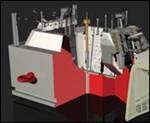Five Benefits of Integrated CAD/CAM
Integrated CAD/CAM software that combines CAD, CAM, electrode design and CMM programming capabilities in one system can save you time and effort in the following five ways:
1. Eliminate extra and costly data translation steps between applications that are operating on the same 3-D model. Some systems offer a complete set of fully integrated applications for the complete process from part design through mold design, NC programming, electrode design and CMM inspection programming.
2. Automate more of the manufacturing authoring process: (a) automate NC and CMM programming by using design requirements (GD&T and product manufacturing information (PMI), and color coding) directly on the 3-D model; and, (b) store NC data inside the standard part’s 3-D model file. For example, the NC data inside a standard slide model can be easily updated to its determined design dimensions.
3. Use integrated validation tools throughout the process. Integrated CAD/CAM systems can include tools to validate (and even improve) part and tool designs: molded part manufacturability checks, injection molding simulation and tool motion simulation with collision detection. Before machining, validate NC data with integrated g-code driven machine tool simulation.
4. Keep your data organized so you can work in teams, work in parallel and react faster to design changes. For example, using a master model with associativity allows you to update your mold design, NC programs, electrodes and setup sheets when the CAD model changes. Associativity makes design changes go faster and simple changes can be updated automatically— they don’t require reprogramming because they automatically re-adjust. More than one designer can work on the same tool at the same time; and, you can start NC programming before the tool design is completed.
5. Share knowledge between departments so designs can be done right the first time with manufacturability taken into consideration. When everyone works on the same system, this is much easier to do and the benefits can be substantial. Unfortunately in some cases, designers do not realize the impact of their decisions on the manufacturing process. Design features that are difficult to manufacture can add extra costs to jobs. They can add extra manufacturing steps and extra NC programming time due to feature redesign. When NC programmers and designers work with the same system, it’s much easier for both disciplines to work together. Some CAD/CAM systems have the ability to copy features and store them in a library for later use or can create custom features. When this is the case, NC programmers can work with designers to specify features that include manufacturability considerations. Designers can reuse these features from a library (saves design time) with the confidence that manufacturing knows how to machine them.
When you are able to start with a clean sheet and complete the whole process with the same system, the value of using one integrated CAD/CAM system pays off. Besides the process-based benefits summarized above, additional benefits are to be gained in the forms of reduced training costs due to one easy-to-learn consistent user interface, administration of one system and working with one vendor.
Related Content
-
How to Determine the Proper Vent Depth
Vent depth is critical to optimizing mold performance, so here is one approach to finding that elusive right number.
-
Line Width vs. Depth Ratio in Laser Engraving
A laser does not produce 90-degree sidewalls. It requires a certain amount of draft in order to produce the required pattern.
-
Revisiting Some Hot Runner Fundamentals
What exactly does a hot runner do? If you’ve been in the injection molding industry for any length of time, you might think the answer is obvious, but it is not.












